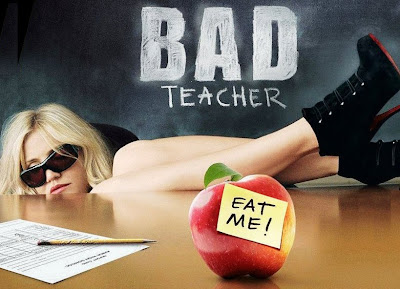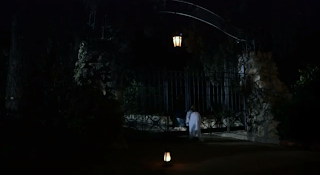Bad Teacher Trailer Review

The narrative of this trailer is conveyed to the audience through the dialogue between the main character, Elizabeth Halsey, played by Cameron Diaz and other supporting characters. This dialogue really shows Ms.Halsey's comical and extremely inappropriate personality. Through direct dialogue, it becomes obvious that this film is very humorous, we know right away that this teacher has completely corrupt morals as well as her indifference about her job, however she is still very likable due to her absurd charm.

The Mis En Scene of the film first presents Ms.Halsey as a careless teacher who is still somewhat of a kid herself, in the opening scene she forgets the first day of school and then states that she is not going to go, she then mocks the other teacher when she says its mandatory and then swears.Right off the bat we know this teacher is extremely awful. To further explore Ms.Halsey's vulgar personality, we then see several scenes in which her actions portray her, for example intoxication at the school, calling students stupid, throwing papers at kids and calling them morons etc. The trailer then presents an obstacle for the main character, Ms.Halsey, she states that "My full time job is know finding a guy who is gunna take care of me".She meets another new teacher Scott Delacorte, played by Justin Timberlake. When she finds out that he is rich she wants to be in a relationship with him. After seeing his old girlfriend, she believes that if she gets breast surgery then Scott will be more attracted to her and want to be in a relationship as well. Then next scenes of the trailer then shows what she is willing to do to get the money for her breast surgery, this includes a bonus that is given to the teacher who has the highest test scores. When then see Ms.Halsey strive for the bonus with some competition, from the antagonist, a fellow teacher that disproves of her. Overall the trailer does a good task in explain to the audience character, character personality, setting, obstacle, and a goal.

 The cinematography of the trailer further pushes the characters on a comedic level, highlighting Ms.Halsey's willingness to do anything, no matter how crude, to get her surgery.The trailer includes a girl saying that the school car washes make alot of money. In the next scene we see Ms.Halsey in skimpy clothes washing cars while men and boys gawk at her.Many of these shots have been copied several times, given the sensual classic look of a women with a car. However what makes this scene funny is the reaction shots of the men as Ms.Halsey flaunts herself in order to get men to spend there money at the car wash. We see all the men with open mouths and even a policeman who is gazing at her while driving, runs into another. In the shot to the left, I love the lighting in which not only illuminates her but also the water being sprayed. This is a very prominent way to give off seductive mood in the shot. In both pictures, right and left ,we see that camera position placing her right in the middle of the shot. thus allowing us to focus on her more then anything else and also gives her a more flattering look using the car. If this shot had used the rule of thirds it may appear more artsy but then it would not humorous and the audience wouldn't fully have direct attention on her.
The cinematography of the trailer further pushes the characters on a comedic level, highlighting Ms.Halsey's willingness to do anything, no matter how crude, to get her surgery.The trailer includes a girl saying that the school car washes make alot of money. In the next scene we see Ms.Halsey in skimpy clothes washing cars while men and boys gawk at her.Many of these shots have been copied several times, given the sensual classic look of a women with a car. However what makes this scene funny is the reaction shots of the men as Ms.Halsey flaunts herself in order to get men to spend there money at the car wash. We see all the men with open mouths and even a policeman who is gazing at her while driving, runs into another. In the shot to the left, I love the lighting in which not only illuminates her but also the water being sprayed. This is a very prominent way to give off seductive mood in the shot. In both pictures, right and left ,we see that camera position placing her right in the middle of the shot. thus allowing us to focus on her more then anything else and also gives her a more flattering look using the car. If this shot had used the rule of thirds it may appear more artsy but then it would not humorous and the audience wouldn't fully have direct attention on her. 
 The edit of this trailer really shows the contents of the movie without giving it to much information to ruin the story. The overall time of the trailer is 2 minutes and 29 seconds, this is a fairly long trailer, but it uses the time very well to convey to the audience the purpose of the film. Several thing included in this trailer where many of the names of the actors or small descriptions were in the titles. However almost everything that is explained is through the film itself.
The edit of this trailer really shows the contents of the movie without giving it to much information to ruin the story. The overall time of the trailer is 2 minutes and 29 seconds, this is a fairly long trailer, but it uses the time very well to convey to the audience the purpose of the film. Several thing included in this trailer where many of the names of the actors or small descriptions were in the titles. However almost everything that is explained is through the film itself.Lastly the Sound Design fits well with the trailer, it uses many of the songs that were popular during this year and that are relative to the section of the film. For example, when Ms.Halsey is meeting Scott for the first time and she is talking about how she needs him to be attracted to her, she then changes her persona in a more respectable manner anytime she is around him, the name of the song in the background is"Tighten Up", this song talks about love and needing it. Another example would include when Ms. Halsey is desperate for money and she does anything she can for funds, as we see this we hear "Beggin" by Madcon. These songs further push the motive of the character and the plot.

























.jpg)





















